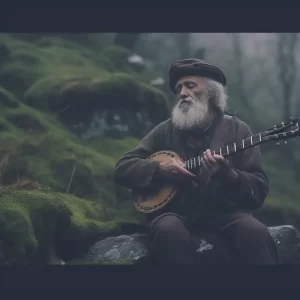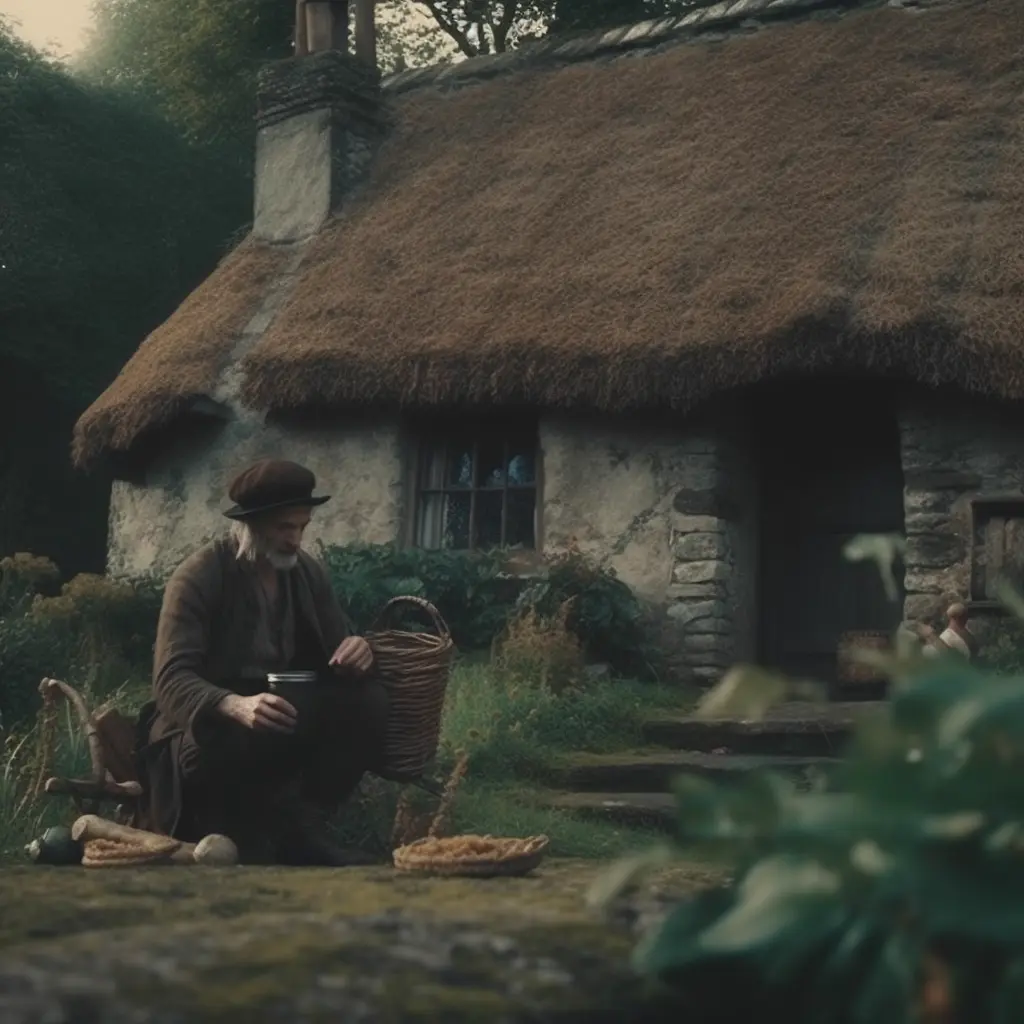Irish Folk Magic: A Brief Overview of Its History and Practices
Irish folk magic has been an integral part of Irish culture for centuries. It is a blend of ancient Celtic beliefs, Christianity, and superstitions. The practice has been passed down through generations and is still prevalent in modern-day Ireland.
Folk magic in Ireland relies heavily on the power of nature, spirits, and the unseen world. It involves the use of spells, charms, and rituals to bring about desired outcomes. The practitioners of Irish folk magic, known as “cunning folk,” were highly respected members of their communities. They were sought after for their ability to heal the sick, protect against evil spirits, and even curse their enemies.
What is Irish Folk Magic?
Irish Folk Magic, also known as Celtic Folk Magic, is a form of magic that has been practiced in Ireland for centuries. It is a combination of pre-Christian traditions, mythology, and common folk beliefs that have been passed down through generations. The practice of Irish Folk Magic involves the use of charms, spells, herbs, and other natural remedies to heal, protect, and bring good luck.
Irish Folk Magic is deeply rooted in the country’s history and culture. It is a reflection of the Irish people’s connection to the land, the Sidhe (fairy folk), and their deities. The practice of Irish Folk Magic has been intertwined with the country’s religion, mythology, and folklore for centuries.
Magical practitioners in Ireland, known as Bean Feasa, have been revered for their abilities to heal, protect, and provide guidance to their communities. They were highly respected members of their communities, and their knowledge of Irish Folk Magic was passed down through generations.
One of the most common forms of Irish Folk Magic is the use of poultices, which are made from herbs and other natural ingredients. Poultices were used to treat a variety of ailments, from headaches to broken bones. Another popular practice was the use of potions, which were made from various ingredients to bring good luck, love, or to ward off evil spirits.
In addition to poultices and potions, Irish Folk Magic also involved the use of spells and charms. One of the most famous spells is the Blast, which was used to curse enemies. Charms were used to protect against evil spirits and bring good luck.
The History of Irish Folk Magic
Irish folk magic has a rich and complex history that spans centuries, drawing on a variety of influences from Ireland’s pre-Christian past to its more recent Christian traditions. Folk magic in Ireland has been shaped by the country’s unique cultural and historical context, including its Celtic mythology, Middle Ages, and interactions with Britain.
Superstition has played a significant role in the development of Irish folk magic, with many beliefs and practices passed down through generations. Christianity also had an impact on the development of folk magic, with many practices and beliefs being incorporated into Christian traditions.
Witches and witchcraft have played a prominent role in Irish folklore, with many stories and legends featuring witches as powerful and sometimes malevolent figures. However, the term “witch” was not always used in Ireland, and many magical practitioners were referred to as “folk healers” or “wise women” instead.
Folk healers and folk medicine have been an important part of Irish culture for centuries, with many people turning to these practitioners for remedies and cures. These healers often used a combination of herbal remedies, potions, and spells to treat a variety of ailments.
Celtic mythology and pre-Christian traditions also played a significant role in the development of Irish folk magic. Deities such as the Morrigan and Brigid were also associated with magic and were often invoked in spells and rituals.
Irish Folk Magic Rituals and Practices
Irish folk magic rituals and practices are deeply rooted in the country’s ancient traditions and beliefs. These practices include various charms, prayers, and faith-based rituals that have been passed down from generation to generation. The use of stones and trees to harness energy is also a common practice in Irish folk magic.
Folk healers, also known as “bean feasa,” are highly respected in Irish culture. They use their knowledge of folk medicine to heal various ailments using natural remedies such as poultices and potions. These remedies are often made from herbs and plants found in the mountains and other natural areas.
One of the most well-known Irish folk magic rituals is the May Eve celebration, also known as “Beltane”. This celebration is held on the first of May and is a time to honor the goddess Brig and her male counterpart, the Oak King. During this celebration, fires are lit, and offerings are made to the deities.
Holy wells are also an important part of Irish folk magic. These wells are believed to have healing properties and are often visited by those seeking relief from various ailments. Offerings are left at the wells, and prayers are said in hopes of receiving healing and protection.
The Sidhe, also known as faeries, are an important part of Irish folklore and are often invoked in folk magic rituals. These beings are believed to live in the underworld and have the power to bestow blessings or curses on humans.
Piseogs, or malevolent magic, is also a part of Irish folk magic. These spells are enacted with evil intent and are meant to cause harm to others. However, it is believed that the power of these spells can be reversed by the use of counter-charms and other protective measures.
In recent years, the popularity of Wicca and other forms of modern witchcraft has grown in Ireland. Many practitioners of these modern traditions incorporate elements of Irish folk magic into their practices, such as honoring the goddess Cailleach and using the energy of stones and trees in their rituals.

Notable Figures in Irish Folk Magic
Irish folk magic has a rich history of notable figures who have contributed to the practice and development of this art over the centuries. These figures have come from various backgrounds and have brought their own unique perspectives and techniques to the craft.
One of the most well-known figures in Irish folk magic is the Father. The Father was a term used to describe a practitioner of folk magic who was believed to have special powers and abilities. They were often consulted for healing, protection, and the removal of curses.
Witches and cunning folk were also prominent figures in Irish folk magic. These individuals were believed to have the power to cast spells, create potions, and communicate with spirits. They were often sought out for their expertise in matters of love, wealth, and health.
In the 20th century, French and Italian folk magic traditions had a significant influence on Irish folk magic. This influence can be seen in the use of eggs as a form of punishment or cursing, as well as the incorporation of Catholicism and Protestantism into the practice.
Saints and Celtic deities were also important figures in Irish folk magic. They were often invoked for protection, healing, and guidance. Folk healers and practitioners of folk medicine also played a crucial role in Irish folk magic, using their knowledge of herbs and natural remedies to heal the sick and injured.
Welsh, Finnish, German, Spanish, and Swedish folk magic traditions also had an impact on Irish folk magic. These traditions brought new techniques and perspectives to the craft, such as the use of poultices for toothache and the belief in an underworld inhabited by spirits.
Piseogs, or superstitions, were also an integral part of Irish folk magic. These beliefs included the use of holy wells for healing and the wearing of certain charms and amulets for protection. Faeries and other supernatural beings were also believed to play a role in Irish folk magic, and were often invoked for protection and guidance.
Voodoo and other forms of malevolent magic were also present in Irish folk magic, particularly around May Eve. The Cailleach, a figure from pre-Christian traditions, was also an important part of Irish folk magic. She was believed to be a goddess of the mountains and was often invoked for protection and guidance.
In modern times, practitioners such as Morgan Daimler and Wiccans have continued to contribute to the development of Irish folk magic, incorporating new techniques and perspectives into the craft. The Bean Feasa, or wise woman, is also an important figure in Irish folk magic, using her knowledge of herbs, spirits, and deities to help others.
Irish Folk Magic Today
While Irish folk magic has been heavily influenced by Christianity, many of its pre-Christian traditions still survive today. The sidhe, or fairy folk, are still believed to exist by many people in Ireland, and offerings are often made to them in the hopes of receiving their blessings.
Despite the influence of Christianity, folk magic has also been associated with witchcraft and has been viewed with suspicion by some members of the Protestant community. In the past, midwives and other folk healers were sometimes accused of practicing witchcraft and were persecuted as a result.
Today, however, folk magic is more widely accepted, and many people in Ireland still turn to it for healing and protection. While it may not be as common as it once was, it remains an important part of Irish culture and continues to be practiced by many common folk.
Frequently Asked Questions
What are some traditional Irish spells?
Traditional Irish spells include love spells, protection spells, and healing spells. These spells often involve the use of herbs, stones, and other natural elements. For example, a traditional love spell might involve burning rose petals and reciting a specific incantation. Protection spells might involve carrying a specific herb or stone on one’s person, or placing protective symbols around one’s home.
What is the significance of the color green in Irish magic?
Green is a significant color in Irish magic because it represents the natural world and the power of the earth. It is associated with growth, fertility, and abundance. Many Irish spells and rituals involve the use of green candles, herbs, or stones.
What are some common ingredients used in Irish folk magic?
Common ingredients used in Irish folk magic include herbs such as lavender, rosemary, and thyme, as well as stones like quartz and amethyst. Other natural elements such as water, fire, and earth are also used in various spells and rituals.
What are some popular Irish folk magic rituals?
Popular Irish folk magic rituals include the use of divination tools such as tarot cards and runes, as well as the practice of fire scrying and water scrying. Other rituals might involve the creation of protective charms or the use of specific herbs and stones in healing rituals.
What is the role of fairies in Irish folk magic?
Fairies play a significant role in Irish folk magic, as they are believed to be powerful magical beings who can offer blessings or curses to humans. Many Irish spells and rituals involve invoking the aid of the fairies, or making offerings to them in exchange for their assistance.
How does Irish folk magic differ from other forms of Celtic magic?
Irish folk magic is similar to other forms of Celtic magic in its use of natural elements and its focus on the power of the earth. However, it has its own unique traditions and practices that set it apart from other forms of Celtic magic. For example, the use of fairies and other magical beings is more prominent in Irish folk magic than in other forms of Celtic magic.


